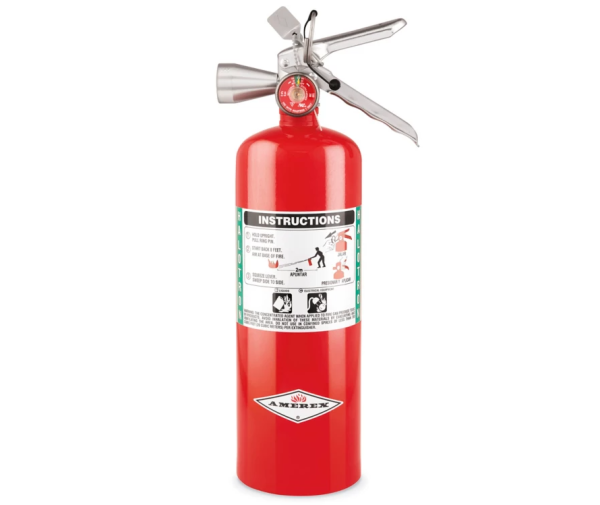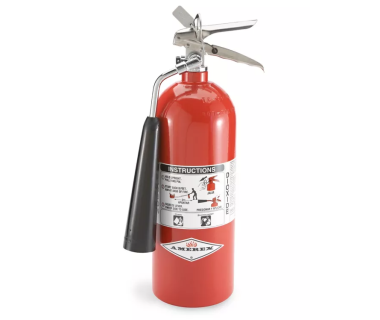Clean Agents: Fire Extinguisher Choices
“Safety Moments, presented at CCA Stations and Posts”
By Chuck Hawley, October 4, 2023, San Francisco Station
Safety at Sea courses are held across the country, generally at a host yacht club, and as a result the speakers and organizers try to reduce their impact on the regular members of the host club. However, many of the activities are inherently messy: debris ends up in the pool, used flares end up in the garbage, and fire extinguisher “agent” coats the parking lots.
CCA Member Bruce Brown, one of the SAS course moderators, recommended that I buy a CO2 portable extinguisher for use in the hands-on courses primarily because it leaves no debris or dust behind after its use. Once the fire (generally gasoline, burning in a turkey roasting pan filled with gravel) is extinguished, there’s no sign that there was ever an extinguisher in use other than the absence of fire.
Another family of extinguishing agents that leaves nothing behind is one based on the halon family of chemicals, which generally consist of a carbon atom connected to chlorine, fluorine, iodine, and bromine atoms. Certain halon molecules are very effective in extinguishing fires that are found on recreational boats, and equally importantly, have varying effects on our environment, particularly the ozone layer. This is a complicated topic, and beyond the scope of this Safety Moment (as well as the chemistry knowledge of the author), but two of the very effective chemicals from 30 years ago turned out to be terrible for the deterioration of the ozone layer: Halon 1211 and Halon 1301. Production of these chemicals in much of the world was stopped in the mid 1990s, although the chemicals are still valuable in specific applications and are widely recycled.

Fast forward to the Encinal Yacht Club in Alameda, CA which hosted the Pacific Cup Yacht Club International Offshore Safety at Sea course this past weekend. I ran the “flare and fire” station during the weekend, allowing sailors to practice with a variety of signal flares as well as allowing them to extinguish the gasoline fire in the roasting pan. Over the course of the weekend, we lit and extinguished about 40 fires, using the portable CO2 extinguisher ($130 second hand) which did an admirable job of extinguishing the fire over and over with no mess. A single 5# extinguisher lasted for the entire weekend, but I encouraged the students to use a well-aimed blast of gas which would extinguish the fire in a second or two. I say “well-aimed” because a gasoline fire that isn’t entirely smothered by the CO2 will quickly re-establish itself and require a second blast.
Each group was also shown the effectiveness of the inexpensive ABC or BC dry chemical extinguishers, again using a short well-aimed blast at the fire. However, during one of my demonstrations, I accidentally grabbed the halon extinguisher that I had used in a discussion of different fire-fighting agents. I pulled the pin, aimed the nozzle and let forth a brief blast of banned, terrible-for-the-environment, not-Sierra Club approved halon.
Man, was it effective. From a distance of about eight feet, the gas enveloped the fire and immediately put it out. The fire was out before I could release the valve. But I realized that I had used the wrong extinguisher and I fessed up to the students about my mix-up. Instead of a cloud of messy particles, I had released a cloud of environmentally damaging gas.
So, what did I learn?
- Many items with subtle but important differences may get mixed up, especially in the hurry to put out a fire or some other time-critical action. Make sure you know that you’ve got the correct signal flare, the correct fuel container, or the correct extinguisher.
- Having a non-powder extinguisher onboard, especially for electrical and galley fires, is a good idea. Powdered extinguishing agents are extremely difficult to clean up, and they can cause corrosion if left in place. Fire blankets also work effectively on small galley fires, without creating a mess.
- Technique is important. You have to get all the fire out with a CO2 extinguisher or it will relight and you’ll have to start over.
The Cruising Club of America is a collection of accomplished ocean sailors having extensive boat handling, seamanship, and command experience honed over many years. “Safety Moments” are written by the Club’s Safety Officers from CCA Stations across North America and Bermuda, as well as CCA members at large. They are published by the CCA Safety and Seamanship Committee and are intended to advance seamanship and safety by highlighting new technologies, suggestions for safe operation and reports of maritime disasters around the world.






